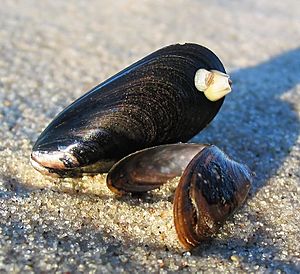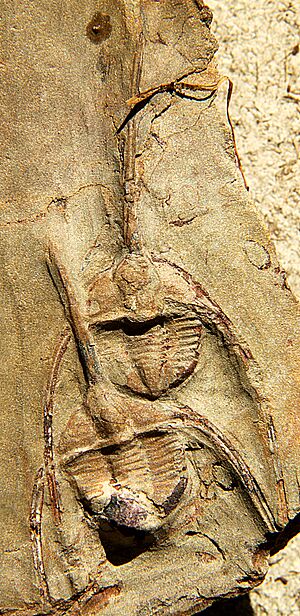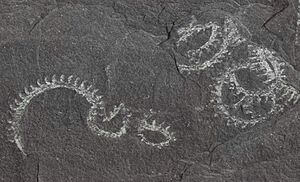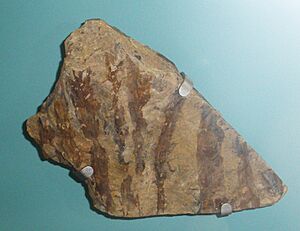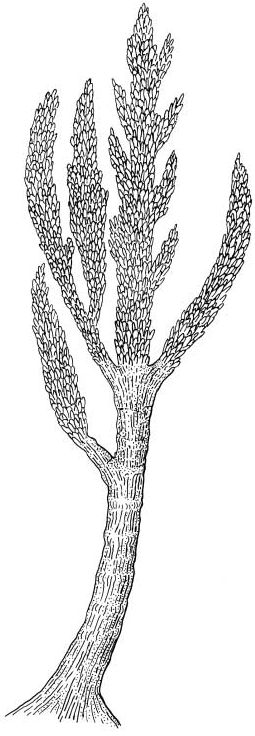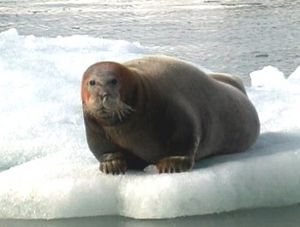List of the prehistoric life of Maine facts for kids
This article is about the amazing ancient life found in Maine! It lists all the different kinds of prehistoric plants and animals whose fossils have been discovered in the state. Fossils are like clues from the past – they are the preserved remains or traces of living things from long, long ago. By studying these fossils, scientists can learn about the creatures that once roamed, swam, or grew in Maine millions of years ago.
Contents
Ancient Life in Maine: The Precambrian Era
The Precambrian Era was the earliest time in Earth's history, lasting from when the Earth formed (about 4.5 billion years ago) until about 541 million years ago. During this incredibly long period, the first simple life forms appeared, like tiny bacteria and algae. However, scientists haven't found any fossils from the Precambrian Era in Maine yet. This means that either no life existed there at that time, or any fossils that did form have been destroyed or are still hidden deep underground.
Life in the Paleozoic Era: Maine's Ancient Seas and Lands
The Paleozoic Era stretched from about 541 to 252 million years ago. During this time, life on Earth exploded! Maine was often covered by shallow seas, which means many of the fossils found here are from ocean creatures. Later, plants started to grow on land, and some of their fossils are also found.
Let's look at some of the cool creatures and plants from Maine's Paleozoic past:
Ocean Dwellers: Trilobites and Brachiopods
Many fossils from the Paleozoic Era in Maine belong to creatures that lived in the ocean. Two common types are trilobites and brachiopods.
- Trilobites: Maine's Ancient Bugs
Trilobites were amazing sea creatures with hard, segmented bodies, a bit like modern-day crabs or insects. They are called "trilobites" because their bodies were divided into three main parts, or lobes. They lived on the seafloor and are some of the most famous fossils found. * One type of trilobite found in Maine is †Ampyx. These trilobites had a distinctive long spine on their head. * Another trilobite discovered here is †Illaenus. These were smooth-bodied trilobites that could roll up into a ball for protection, much like a pill bug does today.
- Brachiopods: Shells of the Past
Brachiopods are marine animals that look a bit like clams, but they are actually very different. They have two shells, but unlike clams, their shells are symmetrical from side to side, not from top to bottom. They lived attached to the seafloor. * Some brachiopods found in Maine include †Atrypa and †Leptaena. These are common fossils that tell us about the ancient ocean environments.
Graptolites: Tiny Floating Colonies
Graptolites were tiny, colonial animals that lived in the ocean, often floating freely or attached to seaweed. They looked like small, saw-toothed branches. Their fossils are important because they help scientists figure out the age of rocks.
- One type of graptolite found in Maine is †Monograptus. Many different species of Monograptus have been identified, showing how diverse these floating colonies were.
Early Land Plants: Maine's First Forests
As the Paleozoic Era continued, plants began to move from the water onto land. Maine has fossils of some of these very early land plants.
- †Drepanophycus was an early plant that looked a bit like a club moss. It had small, spine-like leaves.
- †Pertica is another fascinating early plant found in Maine. It was one of the first plants to grow upright and branch out, looking somewhat like a small tree. Maine is a special place for Pertica because its first fossils were discovered here!
- †Psilophyton was a very simple early land plant with no true leaves or roots, just branching stems. Many different species of Psilophyton have been found in Maine.
- †Prototaxites was a huge, tree-like organism that grew during the Silurian and Devonian periods. For a long time, scientists weren't sure if it was a plant, a fungus, or something else entirely, but now many believe it was a giant fungus!
The Mesozoic Era: No Dinosaurs in Maine?
The Mesozoic Era, often called the "Age of Dinosaurs," lasted from about 252 to 66 million years ago. This was the time when huge dinosaurs roamed the Earth. However, just like the Precambrian Era, scientists have not found any fossils from the Mesozoic Era in Maine. This might be because the rocks from that time period are not present or exposed in Maine, or perhaps the conditions weren't right for fossil formation. So, no dinosaur fossils have been found in Maine!
Life in the Cenozoic Era: Maine's Recent Past
The Cenozoic Era is the most recent era, starting about 66 million years ago and continuing to today. This is often called the "Age of Mammals." During parts of the Cenozoic, especially the Ice Ages, Maine was covered by glaciers. As these glaciers melted, they left behind sediments where fossils of more recent animals can be found.
Mammals of the Ice Age
During the Ice Ages, large mammals roamed North America, and some of their remains have been found in Maine.
- Mammoths: Giant Elephants of the Past
†Mammuthus, also known as mammoths, were huge, hairy relatives of today's elephants. They lived in cold environments and were well-adapted to the Ice Age. Finding mammoth fossils in Maine tells us that these giant creatures once lived here.
- Bison: Ancient Herds
Bison are large, hoofed mammals, similar to the bison we see today in places like Yellowstone National Park. Their fossils in Maine show that these powerful animals were also part of the ancient landscape.
- Seals and Walruses: Ocean Mammals
Fossils of marine mammals like the bearded seal (Erignathus barbatus) and the walrus (Odobenus rosmarus) have been found. These animals are still alive today, but their fossils show they have been part of Maine's coastal environment for a long time.
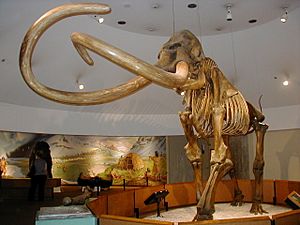
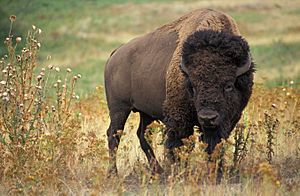
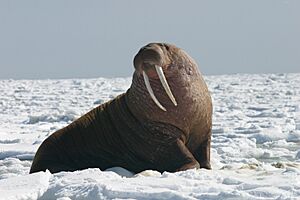
Shellfish and Other Sea Creatures
Many fossils from the Cenozoic Era in Maine are from shellfish and other marine invertebrates. These creatures lived in the ancient seas that covered parts of Maine after the glaciers melted.
- Clams and Mussels: Common Shells
Many types of clams and mussels have been found, including Mya (like the soft-shell clam) and Mytilus (blue mussels). These are very common today, and their fossils show they have been around for a long time.
- Snails: Spiraled Shells
Different kinds of sea snails, like Buccinum and Neptunea, have also left their fossilized shells behind.
